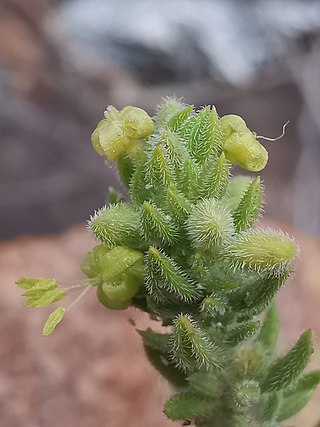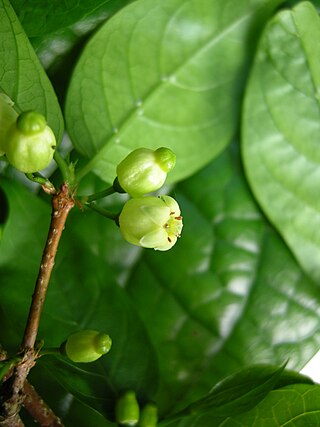
Anthospermum is a genus of flowering plants in the family Rubiaceae. It is found in tropical and southern Africa, Madagascar, and the southwestern Arabian Peninsula.
Ixora foliosa is a species of flowering plant in the family Rubiaceae. It is found in western Cameroon and eastern Nigeria. Its natural habitats are subtropical or tropical moist lowland forests and subtropical or tropical moist montane forests. It is threatened by habitat loss.
Keetia is a genus of flowering plants in the family Rubiaceae. It consists of climbers or scrambling shrubs, rarely small trees.
Mitriostigma barteri is a species of plant in the family Rubiaceae. It is found in Cameroon and Equatorial Guinea. Its natural habitat is subtropical or tropical moist lowland forests. It is threatened by habitat loss.
Multidentia is a genus of flowering plants in the family Rubiaceae.
Pauridiantha insularis is a species of plant in the family Rubiaceae. It is endemic to São Tomé Island.
Pavetta brachycalyx is a species of plant in the family Rubiaceae. It is endemic to Cameroon. Its natural habitats are subtropical or tropical moist lowland forests and subtropical or tropical moist montane forests. It is threatened by habitat loss.
Pavetta monticola is a species of plant in the family Rubiaceae. It is found in Equatorial Guinea and São Tomé and Príncipe.

Rothmannia is a genus of flowering plants in the family Rubiaceae. It was described in 1776 and is named for Göran Rothman (1739–1778) by Thunberg – both were pupils of Linnaeus.

Rytigynia is a genus of flowering plants in the family Rubiaceae. It is found in tropical and southern Africa. The genera Rytigynia and Fadogia form a strongly supported clade but neither of these genera is monophyletic.

Vangueria is a genus of flowering plants in the family Rubiaceae. The genus is named for Voa vanguer, as V. madagascariensis is known in Malagasy.
Vangueriopsis is a genus of flowering plants in the family Rubiaceae.

Vanguerieae is a tribe of flowering plants in the family Rubiaceae and contains 671 species in 29 genera. It is one of the most species-rich groups within the family and it is distributed across the Paleotropics.

Fadogia is a genus of flowering plants in the family Rubiaceae. The genera Rytigynia and Fadogia form a strongly supported clade but neither of these genera is monophyletic.

Meyna is a genus of flowering plants in the family Rubiaceae.

Vangueriella is a genus of flowering plants in the family Rubiaceae. The genus is found in tropical Africa.
Cornelis Eliza Bertus Bremekamp was a Dutch botanist.
Vangueria agrestis is a species of flowering plant in the family Rubiaceae. It is found from West Tropical Africa to Sudan.
Vangueria cinerascens is a species of flowering plant in the family Rubiaceae. It is found from Tanzania to South Tropical Africa. The epithet is a Latin adjective meaning ash-coloured, referring to the indumentum on the leaves.
Vangueria cistifolia is a species of flowering plant in the family Rubiaceae. It is found in Angola and Zambia.







